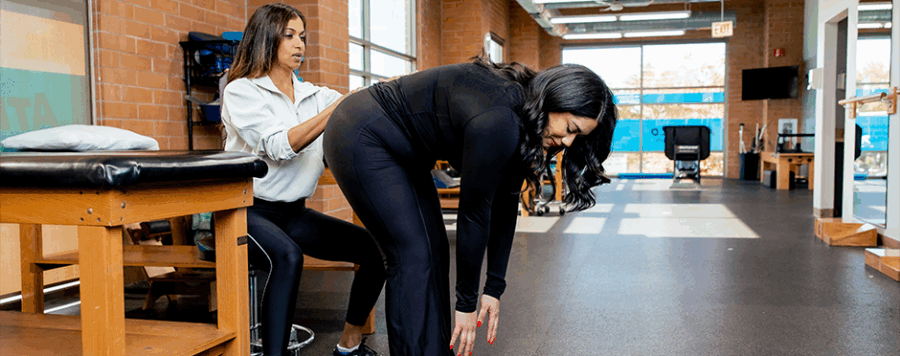At Athletico, we work with patients every day to improve their joint and muscle mobility. Below, we’ll explain range of motion and why it matters and share five tips you can use today to start moving and feeling better.
Disclaimer: These tips are for general education and may not suit all conditions. Always consult a licensed healthcare provider before starting a new mobility routine.
What Is Range of Motion, and Why Is It Important?
Range of motion refers to how far and freely a joint or muscle can move in a particular direction. Flexibility and mobility go hand-in-hand here; tight muscles can restrict joint motion, while stiff joints can limit muscle function.
Common causes of limited ROM include:
- Injury or surgery
- Muscle tightness or imbalance
- Joint stiffness or arthritis
- Poor posture or prolonged inactivity
Restoring range of motion isn’t just about stretching — it’s about retraining your body to move efficiently again. Improved ROM can reduce pain, lower the risk of injury, and even enhance athletic performance.
Tip #1: Stretch With Purpose
Not all stretching is created equal. Static stretching (holding a stretch for 20–30 seconds) helps improve flexibility, especially post-exercise. Dynamic stretching (active movements that stretch muscles through motion) is better before workouts to prepare the body for activity.
Example – Hip Flexor Stretch: Tight hip flexors are a common issue, especially for people who sit often. A kneeling hip flexor stretch can help:
- Start in a lunge position with one knee on the ground.
- Shift your weight forward until you feel a stretch in the front of your hip.
- Hold for 30 seconds, repeat 2–3 times per side.
Tip #2: Don’t Forget About Joint Mobility
Sometimes it’s not the muscles, but the joints that need attention. Controlled articular rotations (CARs), foam rolling, and active mobility drills can all help restore joint motion.
Example – Spinal Rotation Drill: Your spine is designed to twist, bend, and move — but poor posture and stiffness can reduce that ability.
Try this seated spinal rotation:
- Sit tall in a chair with feet flat.
- Cross your arms across your chest.
- Slowly rotate your upper body to the right, pause, then return to center.
- Repeat on the left. Perform 10 reps per side.
This helps gently restore thoracic spine mobility — important for back health and upper body movements like throwing or swinging.
Tip #3: Use Movement to Your Advantage
Sometimes the best way to restore range of motion is through active movement, not just passive stretching. Repetitive motions can help reprogram your nervous system, allowing more movement with less tension or pain.
Examples include:
- Cat-Cow for spinal flexibility
- Hip circles or bridges for pelvic mobility
- Walking lunges for full-body dynamic stretching
Active movement also helps build strength through new ranges, making longer-term improvements.
Tip #4: Consistency Beats Intensity
Regarding flexibility and mobility, slow and steady wins the race. Stretching once a week won’t make much of a difference. But just 5–10 minutes a day of focused mobility work can produce real change over time.
Try adding a short mobility routine to your morning or evening; consistency, not intensity, is key.
Tip #5: Know When to Seek Help
If you’ve been stretching regularly and still feel stiff or restricted, it may be time to consult a physical therapist. Limited range of motion can be caused by underlying issues such as joint capsule tightness, muscle imbalances, nerve tension, or postural dysfunctions.
For example:
Hip impingement may mimic tightness, but it involves joint mechanics requiring hands-on treatment. Back stiffness could be linked to nerve irritation or disc-related issues, not just tight muscles. At Athletico, we assess your movement, flexibility, joint health, and muscle function to find the root cause of your limitations and create a personalized plan to help restore your range safely and effectively.
Restore Motion. Restore Life.
Whether you’re trying to touch your toes again or return to high-level sports, restoring your range of motion is one of the best investments you can make in your long-term health and performance.
Ready to take the next step?
Call your local Athletico clinic today to schedule a free assessment. Our expert clinicians can help you move better, feel better, and prevent future injury with a custom plan built just for you.
*Per federal guidelines, beneficiaries of plans such as Medicare, Medicaid, Tricare, VHA and other federally funded plans are not eligible for free assessments.
The Athletico blog is an educational resource written by Athletico employees. Athletico bloggers are licensed professionals who abide by the code of ethics outlined by their respective professional associations. The content published in blog posts represents the opinion of the individual author based on their expertise and experience. The content provided in this blog is for informational purposes only, does not constitute medical advice and should not be relied on for making personal health decisions.
Zachary Vandenberg has been a physical therapist for over 7 years with a broad range of experience treating orthopedic, vestibular, neuro, and chronic pain populations. He graduated from Marquette University in Milwaukee WI and is now a clinic manager in Northeast WI. In his free time he enjoys biking, live music, and working in the yard.

 width="900"
height="356"
>
width="900"
height="356"
>
